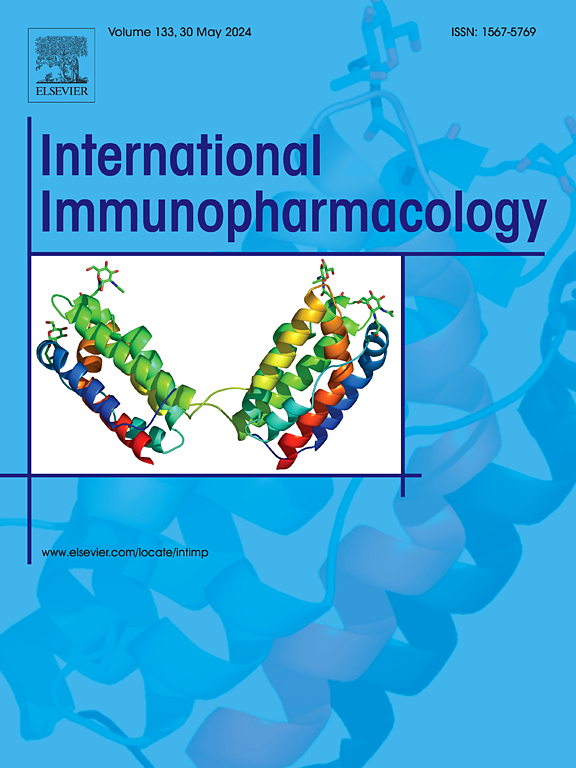在实验性溃疡性结肠炎模型小鼠中,青蒿琥酯通过促进hmgcs2依赖性酮生成促进肠上皮屏障修复
IF 4.7
2区 医学
Q2 IMMUNOLOGY
引用次数: 0
摘要
溃疡性结肠炎(UC)是一种以肠上皮屏障受损为特征的慢性炎性疾病。UC的病因复杂,包括遗传、环境、免疫和微生物因素。最近有人提出,失调的生酮可能在UC的发展中起作用;然而,这种情况发生的确切机制尚不清楚。本研究采用硫酸葡聚糖钠对小鼠进行UC诱导。UC小鼠表现出肠上皮屏障功能障碍,其特征是肠上皮细胞(IECs)紧密连接缺失和外周血中Th17/Treg比例失衡。在UC小鼠iec中,生酮限速酶HMGCS2显著降低,这是导致β-羟基丁酸生成减少的原因。值得注意的是,用青蒿琥酯(ART)处理的UC小鼠显示HMGCS2和酮生成增加,Th17/Treg恢复,紧密连接蛋白表达恢复。这些因素有助于肠上皮屏障修复,减轻结肠炎。AMPK抑制剂或mTOR激活剂的加入有效地逆转了ART对生酮的影响,从而阻止了随后肠屏障的恢复。这些发现在体外dss处理的结肠细胞中得到证实。综上所述,ART通过AMPK/mTOR信号通路刺激IECs中hmgcs2依赖性酮生成,促进UC肠上皮屏障修复。本文章由计算机程序翻译,如有差异,请以英文原文为准。

Artesunate promotes intestinal epithelial barrier repair by facilitating HMGCS2-dependent ketogenesis in experimental ulcerative colitis model mice
Ulcerative colitis (UC) is a chronic inflammatory disorder characterized by an impaired intestinal epithelial barrier. The complex etiology of UC includes genetic, environmental, immune and microbial factors. It has recently been proposed that dysregulated ketogenesis may play a role in the development of UC; however, the precise mechanism by which this occurs remains unclear. In this study, mice were treated with dextran sulfate sodium to induce UC. UC mice exhibited intestinal epithelial barrier dysfunction characterized by loss of tight junctions in intestinal epithelial cells (IECs) and an imbalance in the Th17/Treg ratio in the peripheral blood. A significant decrease in the ketogenic rate-limiting enzyme HMGCS2 was observed in the IECs of UC mice, which was responsible for the decrease of β-hydroxybutyric acid production. Notably, UC mice treated with artesunate (ART) showed increased HMGCS2 and ketogenesis, as well as restored Th17/Treg and recovered tight junction protein expression. These factors contributed to intestinal epithelial barrier repair and alleviated colitis. The addition of an AMPK inhibitor or mTOR activator effectively reversed the effects of ART on ketogenesis, thereby preventing subsequent restoration of the intestinal barrier. These findings were confirmed in vitro in DSS-treated colonocytes. In conclusion, ART facilitated intestinal epithelial barrier repair in UC by stimulating HMGCS2-dependent ketogenesis in IECs through the AMPK/mTOR signaling pathway.
求助全文
通过发布文献求助,成功后即可免费获取论文全文。
去求助
来源期刊
CiteScore
8.40
自引率
3.60%
发文量
935
审稿时长
53 days
期刊介绍:
International Immunopharmacology is the primary vehicle for the publication of original research papers pertinent to the overlapping areas of immunology, pharmacology, cytokine biology, immunotherapy, immunopathology and immunotoxicology. Review articles that encompass these subjects are also welcome.
The subject material appropriate for submission includes:
• Clinical studies employing immunotherapy of any type including the use of: bacterial and chemical agents; thymic hormones, interferon, lymphokines, etc., in transplantation and diseases such as cancer, immunodeficiency, chronic infection and allergic, inflammatory or autoimmune disorders.
• Studies on the mechanisms of action of these agents for specific parameters of immune competence as well as the overall clinical state.
• Pre-clinical animal studies and in vitro studies on mechanisms of action with immunopotentiators, immunomodulators, immunoadjuvants and other pharmacological agents active on cells participating in immune or allergic responses.
• Pharmacological compounds, microbial products and toxicological agents that affect the lymphoid system, and their mechanisms of action.
• Agents that activate genes or modify transcription and translation within the immune response.
• Substances activated, generated, or released through immunologic or related pathways that are pharmacologically active.
• Production, function and regulation of cytokines and their receptors.
• Classical pharmacological studies on the effects of chemokines and bioactive factors released during immunological reactions.

 求助内容:
求助内容: 应助结果提醒方式:
应助结果提醒方式:


